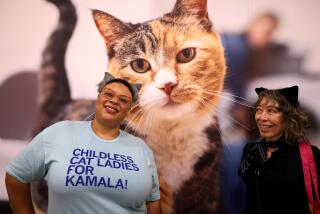At Cat Show, Some Hiss at New Breed
- Share via
As expected, the buzz at this weekend’s San Gabriel Valley Cat Fanciers show focused on a recent advance in the world of cat breeding. But it had little to do with the shorthair cloned kitten that Texas A&M; scientists introduced to the world last week.
Instead, it was the Munchkin--a relatively new breed of short-legged, longhair cat--that generated all the commotion.
In the time-honored tradition of cat breeding, this newcomer has been exempt from most official cat show competitions.
However, an event organizer announced Saturday at the Arcadia Masonic Center that starting May 1, Munchkin cats will be able to enter all competitions held by the International Cat Assn. Applause broke out even before she had finished.
All Munchkins are descended from a single cat: Blackberry, who was found pregnant in a Louisiana barn in the mid-1980s. She passed on her short legs to only half her litter--and ever since, there have been efforts to refine the breed to promote short legs and kitten-like behavior.
Munchkin breeders insist that a spontaneous change in the genetic makeup of the cat introduced the short-legged gene. Still, for many entrants and some officials at the show--people who pay huge amounts of money to breed their own cats to foster the right size tail, correct color eyes and proper fat-to-muscle ratio--the Munchkin represents an unsettling sort of genetic manipulation.
Beth Lewis, a Prescott, Ariz., resident who came to show off Little Sofie, a snowy white, longhair Turkish Van, looked around her at the Abyssinian, Tonkinese and Himalayan cats nearby. They reclined in posh cages decorated in sequins, leopard print and lace, yawning occasionally as their owners coddled them.
“These are natural breeds,” Lewis said.
“Not man-made,” echoed her friend, June Abbot Calwell of Riverside, as she cradled her blue-eyed Siamese cat, Lilac Louie, in her arms.
Would Calwell ever pay to have Lilac Louie--or some other favorite cat--cloned?
“No!” she said, recoiling at the thought. “I’ve had cats that were special. But they were special because they were them. Not copies.”
Nancy Nolen, a judge from Dallas, said she had heard about the work of the scientists at Texas A&M; and might consider cloning a beloved cat. But as far as the Munchkin and other new breeds such as the California Spangled and Ojos Azules are concerned, she was skeptical.
“All new things don’t exactly catch on,” Nolen said about an hour before the announcement about Munchkins was made.
Nolen, 57, a schoolteacher, travels the world judging cat competitions. At the San Gabriel Valley show, she spent most of her day under a silk-flower decorated arch, ferrying cats back and forth from cages to a waist-high competition table.
She poked and prodded the cats before her, feeling under their chins, inspecting their ears, running a practiced finger down delicate spines.
As she worked, Nolen chatted with the cats and their owners. She debated whether one cat, a brown tabby called Tank, was cinnamon or lilac colored. She announced that another, a hissing Burmese named Amanda, could out-swear her any day.
Troya Davidson, 45, of Carson watched from the sidelines as Nolen held her gray household kitten, Satchmo, aloft.
Davidson’s adult female Abyssinian, HillStBlues, had already won enough points to reach Grand Champion status. But she worried aloud that Satchmo was too shy to compete: “If he doesn’t start enjoying it, we won’t bring him to these shows anymore.”
For Davidson, cat shows such as this one are a way to meet cat lovers and learn about other breeds. But as for further manipulation of the species?
“It’s like, I’m glad to know they’ve proven they did it,” she said. “But I see no purpose in cloning cats for the sake of cloning cats. They can do it on their own.”
More to Read
Sign up for Essential California
The most important California stories and recommendations in your inbox every morning.
You may occasionally receive promotional content from the Los Angeles Times.













